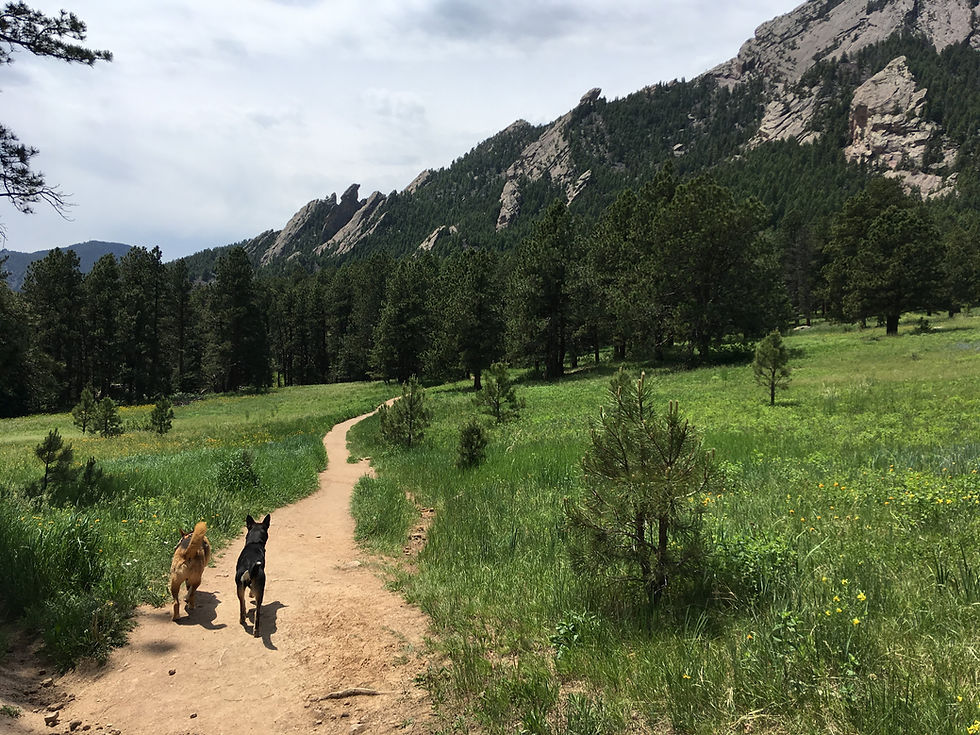How Can you Change the Way You Think About and Relate to Your Dog?
- Alex Canby

- May 29, 2024
- 4 min read
“When you change the way you look at things, the things you look at change.” - Max Planck
Over the course of the past two decades, while running a dog pack leadership program, and training countless therapy and psychiatric service dogs, I have encountered an endless variety of people, all with their own unique mix of canine challenges.
Barking, biting, pulling, digging, chewing, chasing, escaping, and ignoring. These are the surface level challenges that most dog people can easily relate to, but there is a deeper level of challenge. An obstacle that is hidden beneath the surface which has been present in every dog-human family I have ever worked with.
The Reactive Map vs. The Relational Map
Most of us have an understanding of our problematic dog experiences that looks something like this:
My dog is barking in the backyard (Behavior), which makes me feel embarrassed and frustrated, so I end up dragging them back inside (Response).
My dog pulls on the leash (Behavior), which makes me get angry and scold them (Response).
My dog bit another dog (Behavior), which makes me anxious and leads me to avoid all interactions with other dogs (Response).
To state it plainly, our dogs’ behavior determines our emotional and behavioral responses. We can call this way of understanding the Reactive Map.
The challenge with the Reactive Map is that it places us in a state of dependency on our dogs. If I don’t want to feel upset, I need my dog to behave a certain way. When we hold our dogs responsible for our actions and emotional wellbeing, it inevitably leads to a greater need for control on our part.
When people are leading their pack through life with the Reactive Map they tend to get lost, leaning heavily on command and control tactics that fundamentally disrupt trust. You did something I don’t like, therefore I’m going to use my power and authority over you to make you obey.
Most people don’t even see this as a problematic approach. They believe what they need is more control. Better control. Just as I did with my first dog, Batman.
Unfortunately, no amount of dog training can solve the problems that come as a consequence from following the Reactive Map and aiming at obedience. Luckily there is a more accurate map that creates a much clearer understanding of our pack challenges and how they can be addressed effectively.
My dog is barking in the backyard (Behavior). I think the neighbors are going to hate me (Belief), which makes me feel embarrassed and frustrated, so I end up dragging my dog back inside (Response).
My dog pulls on the leash (Behavior). I was taught dogs should always walk nicely next to their owner (Belief), which makes me get angry and scold them (Response).
My dog bit another dog (Behavior). I am certain if we meet another dog it will happen again (Belief), which makes me anxious and leads me to avoid all interactions with other dogs (Response).
By adding one new element (Belief), we begin to see clearly that our thoughts about our dogs dictate how we relate to them. We can call this new way of understanding the Relational Map.
Let’s look at how different beliefs can create wildly different results.
My dog is barking in the backyard (Behavior). My dog must need more mental and physical stimulation (Belief). I feel compassionate and motivated to help (Response).
My dog pulls on the leash (Behavior). My dog is still a puppy and has a limited capacity for focus (Belief). I am patient and gentle (Response).
My dog bit another dog (Behavior). It’s only happened once and I’m not sure it will happen again (Belief). I am calm and open to helping my dog make new friends (Response).
When we begin to examine our pack challenges with the Relational Map, we can see that it is not our dogs’ behavior that makes us respond the way we do, but our beliefs. When we begin to work on improving our beliefs we automatically begin to improve our relationship with our dogs.
The Hidden Challenge
When you begin to follow this new map, it becomes apparent that a deeper, hidden challenge must be addressed. The challenge of letting go.
Letting go of the desire for control. Letting go of the painful beliefs that cause disconnection, fear, and shame. Letting go of our unrealistic expectations and our need for a “perfect” dog.
The process of letting go can seem daunting, confusing, and even irresponsible. If I let go of my fear, I’ll end up putting my pack in dangerous situations. If I let go of my expectations, won’t my dog just devolve into a wild animal? If I let go of my desire for a perfect dog, how will we ever improve? What does “letting go” even mean?
I have wrestled with all of these questions and more. After twenty-plus years of working on my understanding and helping others with similar concerns, I can tell you one thing with certainty: Letting go is not about giving up or giving in.
Letting go is simply a willingness to open our minds to new ways of thinking and thus new ways of being.
This is exactly what the Hidden Habits (the pillars of our dog training curriculum) are designed to help you accomplish.




Comments